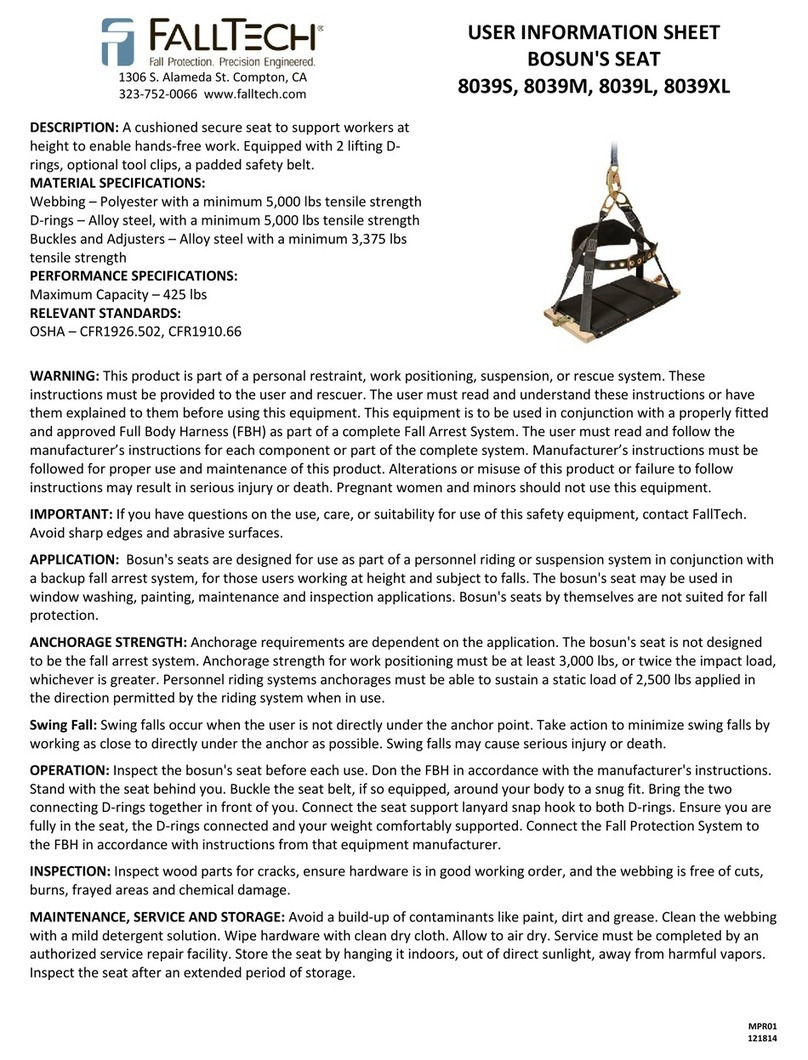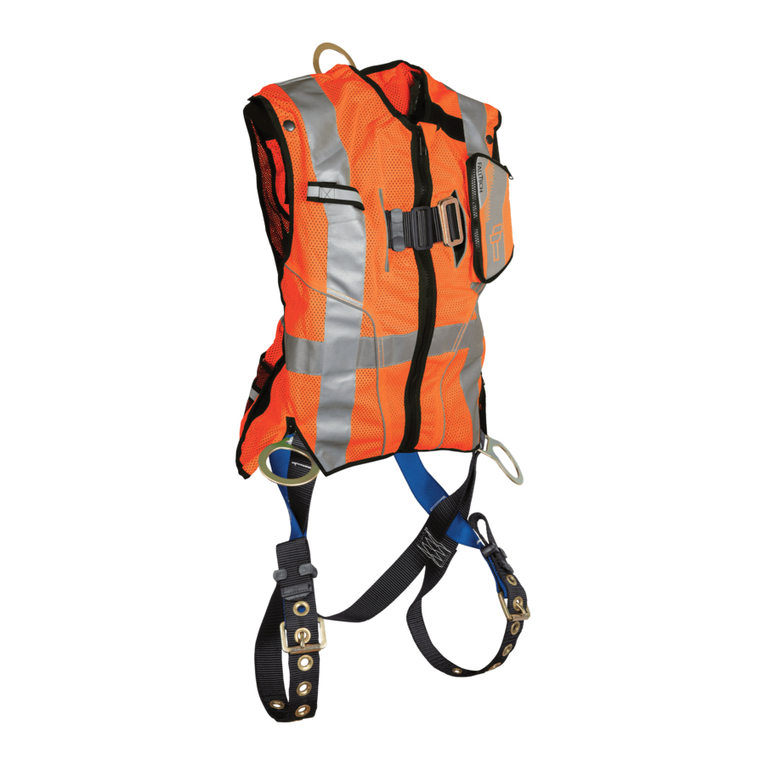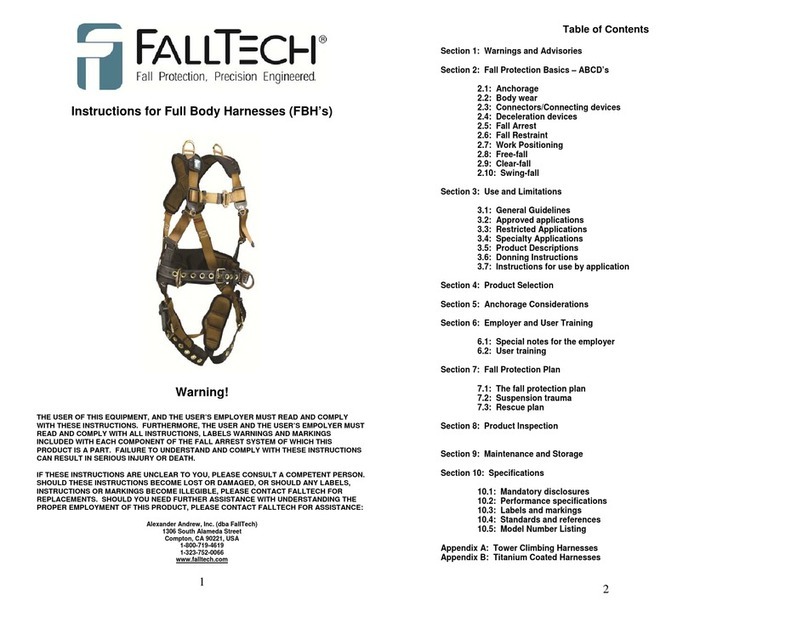
4.0 Installaon and Use
The FallTech SteelGrip® Temporary Cable HLL is sold in a variety of kits and conguraons. The assembly instrucons
listed below may refer to components not included in each kit. For a list of parts included in each kit, see Appendix A.
4.1 Plan the Personal Fall Arrest System (PFAS): Inspect the HLL subsystem before each use in accordance with the procedures detailed in
Secon 6. Examine the work area and take acon to address hazards. Falls are a serious hazard when working at height. Training and
equipment are the tools of fall hazard management. There are several closely related facets of fall hazard management with a PFAS;
• Anchor Point Selecon
• Anchorage Connector
• Deceleraon Device
• Maximum Arrest Force
• Deceleraon Distance
• Minimum Required Fall Clearance (MRFC)
• Body Wear
• Rescue
4.2 Anchor Point Selecon: Select a suitable anchor point. Consider the area where the work is being performed. In an overhead anchorage
condion, the area below the anchorage is the work zone. Lateral movement away from the anchorage is hazardous. As distance from
the anchor increases, the work zone expands, and so does the hazard. Work zone expansion is measured in feet and has a direct inuence
on user safety. Always work as close to the anchor as possible. End anchors selected for use with this system must be a minimum of 5,000
lbs. (22.2 kN). See list of compable FallTech anchors in Appendix A.
4.3 Anchorage Connector: Anchorage Connectors used as part of a PFAS should be designed for use with specied anchor points and
compable with the PFAS components and connectors to be used in the assembly of a complete PFAS. Care should be taken to ensure
proper assembly, installaon and maintenance of all Anchorage Connectors to be used when planning a PFAS. Failure to inspect,
assemble, install and/or maintain Anchorage Connectors could result in injury or death.
4.4 Connectors/Deceleraon Devices: Connectors and Deceleraon Devices such as Shock Absorbing Lanyards, Self-Retracng
Devices/Lifelines, and Fall Arrestor Connector Subsystems (Vercal Lifeline/Rope Grab Combinaons) are designed to connect the user’s
body wear to the Anchorage Connector and/or Anchor Point of a Personal Fall Arrest System.
4.5 Product Assembly and Installaon: System installaon requires end anchor points that are a minimum of 5000 Lbs. in both
vercal and horizontal direcons. The lifeline should be installed to limit free fall to 6’ or less*. When using SRDs the lifeline
must be posioned overhead*. The horizontal lifeline should be posioned in a manner to minimize free fall while allowing ease of use.
Movement away from the lifeline should be limited to reduce the potenal for swing fall. Lifeline end anchors should be
installed at approximately the same elevaon so that the lifeline itself is not sloped more than 5 degrees.
* When using SteelGrip® Stanchions as end anchors for this system, free fall may exceed 6’ when using a shock absorbing
lanyard (SAL), see Secon 2.7. SRDs are acceptable for use as personal energy absorbers.
3.2 Compability of Connectors: Connectors are considered to be compable with connecng elements when they have been designed to
work together in such a way that their sizes and shapes do not cause their gate mechanisms to inadvertently open regardless of how
they become oriented. Contact FallTech if you have any quesons about compability. Connectors must be compable
with the anchorage or other system components. Do not use equipment that is not compable. Non-compable connectors
may unintenonally disengage. Connectors must be compable in size, shape, and strength. Self-closing, self-locking snap hooks
and carabiners are specied by OSHA and ANSI Z359.12.
3.3 Compability of Components: Equipment is designed for use with approved components and subsystems only. Substuons or
replacements made with non-ANSI Z359 compliant components or subsystems may jeopardize compability of equipment and may aect
the safety and reliability of the complete system. Ensure compability between the connectors if non-FallTech components are used for
fall protecon.
3.4 Connectors: Only use self-locking snap hooks, rebar hooks, and carabiners with this equipment. Only use connectors that are suitable to
each applicaon. Ensure all connecons are compable in size, shape and strength. Do not use equipment that is not compable. Visually
ensure all connectors close and lock completely. Connectors (snap hooks, rebar hooks, and carabiners) are designed for use only
as specied in this manual.
MHLL12 Rev A 092117 9































